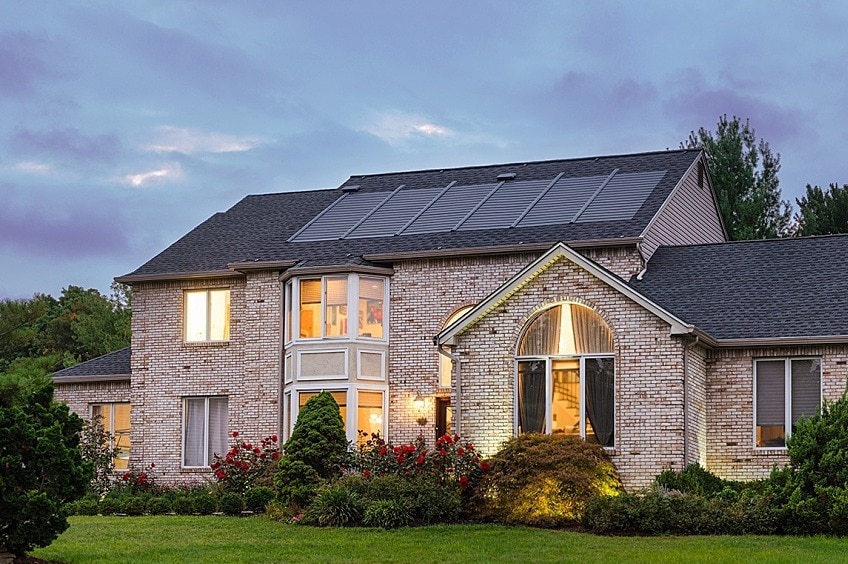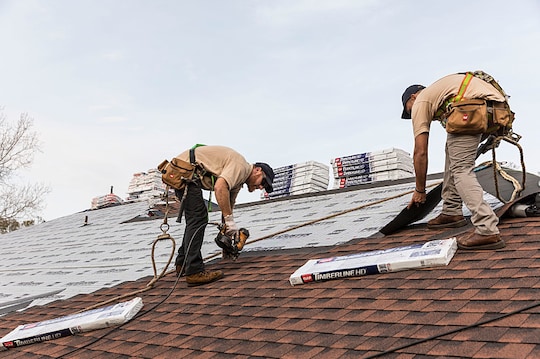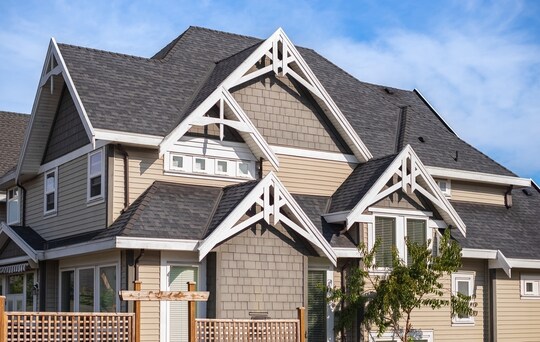
¿Estás pensando en instalar paneles solares en el techo? Muchos factores serán importantes en tu decisión. Allana Helland, directora de marketing de GAF Energy, usa sus más de 10 años de experiencia en la industria solar para orientar a propietarios de viviendas interesados en los techos solares.
Here's what to think over before investing in a solar roof.
1. Solar Panels vs. Solar Shingles
Solar panels and solar shingles are the two most common solar options for homeowners. Both convert sunshine into electricity that can power your home with clean energy, often leading to cheaper long-term energy costs.
Paneles solares
Traditional solar panels have been around for decades, says Helland. "Even with aesthetic and efficiency improvements," how solar panels work has for the most part remained the same. These solar panels typically require a secondary installation, performed by a solar company separate from your roofing company, that goes over an existing roof.
Tejas solares
Rather than requiring a secondary installation, solar shingles are often installed like an architectural asphalt shingle by a qualified roofing contractor. Options such as the Timberline Solar™ roofing system take the "tested and true" reliability of a hardworking asphalt shingle and incorporate solar technology, explains Helland. In fact, Timberline Solar shingles are even nailed on like a regular shingle.
2. Return on Investment
Wondering how long you'll wait until your solar solution pays for itself is common. Online solar tools can help calculate those complicated numbers. As technology evolves, though the question should evolve, too: "What if people were asking if the roof itself could pay back over time?" asks Helland.
Rather than thinking of solar energy as a separate cost from the cost of your roof, consider installing a new roof that comes with solar already integrated. Solar shingles mean you have one contractor and one cost, which is often lower than the two installation costs. And, because solar shingles such as Timberline Solar are installed by roofers in the same amount of time it takes to install a regular roof, they pass on the installation savings to customers.
That is in addition to the long-term cost savings that powering your home with solar energy can already bring. If it's time for a new roof, the payback potential of the newer solar shingles can make it a less expensive option than traditional solar panels. Whether you opt for solar panels or solar shingles, utilize federal incentives and search the Database of State Incentives for Renewables & Efficiency to find tax cuts you may be eligible for.
3. Roof Requirements
Is your roof ready for solar? Roof condition, location, and age are key considerations when installing solar panels.
Your roof's condition-new, old, leaky-impacts installation choices. "Be cautious about putting brand new solar panels on an older roof," Helland warns. Installing panels over an aging or degraded roof could accelerate existing roof problems. Additionally, as with any secondary installation over the roof, any repairs the roof might need in the future may require solar contractors to come and remove the panels before roofing contractors can perform roof repairs. This means coordinating and paying two separate contracting companies.
If you plan to install a new roof, solar shingles—especially those like Timberline Solar™ that are UL 7103-rated as both solar panels and construction materials—can streamline the process. If the roof needs repairs down the line, a qualified roofer can easily access the right areas.
As you weigh your roof's eligibility for solar, look into your SunScore. This rating, from 1–100, measures roughly how suitable your roof is for collecting solar energy based on your location.
4. Maintenance and Cleaning
Energy shingles like Timberline Solar™ and standard architectural shingles like the Timberline HDZ® Shingle age at roughly the same rate. Fortunately, solar shingles and solar panels are low maintenance and don't require much in the way of cleaning.
"Natural soiling is expected," shares Helland. She explains that it's typical of traditional solar panels and doesn't significantly impact energy production. That said, environmental factors that cause heavy soiling, like pollen-producing trees over a roof, might hurt energy production and should be addressed with your installation professional.
Cleaning can be as easy as hosing down or sweeping off the panels or shingles to remove debris-but only when done following appropriate safety measures. If spraying the solar panels with a hose, be mindful of the temperature, as cold water and hot glass could lead to cracking, notes Helland.
5. Withstanding Weather
Think about what your roof will experience throughout the year as it shields you from the elements—and then consider how well solar panels or shingles might fare.
Questions to Ask about Weatherproofing
Wondering whether a solar solution will survive a storm? Solar panels and solar shingles themselves are built to withstand bad weather, and most have warranties covering severe weather damage. However, it can be smart to ask if a traditional solar installation will compromise your existing roof's defenses against the weather, if installation could result in the need for a roof repair or roof replacement, and if installing solar panels will compromise your roofing warranty.
Challenges of Traditional Solar Panels
Comparatively, solar shingles may be more effective at weatherproofing your solar roof than solar panels. Both rack-mounted (raised from the roof) and direct-to-deck (flush with the roof) solar panels are installed by a solar roofing company after the roof is installed by your roofing contractor. These secondary solar installations may jeopardize the initial roof underneath, according to Helland. Any resulting roof holes or other damage could lead to leaks, water damage, and other potentially costly problems.
Because these secondary installations are done after the roof is already in place, and usually not by your roofer, they may compromise or void traditional roof and shingle warranties. Read your warranty's fine print before making your decision.
Benefits of Solar Shingles
Choosing an integrated solution may offer the greatest protection when it comes to both weatherproof design and warranty. Because the Timberline Solar™ Energy Shingle is both a roofing shingle and a solar panel in one, it also requires only one installation by one contractor. GAF Energy wanted to "create something where homeowners didn't have to think about solar-installation weatherproofing issues," says Helland.
Interested in installing solar panels on a roof? Think about how your roof can pay for itself over time, create clean energy, and look good making it happen. Talk with a GAF Certified Contractor* about your solar options.
*Los contratistas inscritos en los programas de certificación de GAF no son empleados ni agentes de GAF, y GAF no controla ni supervisa de otro modo estas empresas independientes. Los contratistas pueden recibir beneficios, como puntos y descuentos de recompensa por lealtad en herramientas de comercialización de GAF por participar en el programa y ofrecer a GAF garantías mejoradas, que requieren el uso de una cantidad mínima de productos de GAF.




